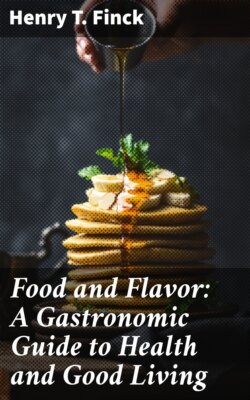Читать книгу Food and Flavor: A Gastronomic Guide to Health and Good Living - Henry T. Finck - Страница 15
На сайте Литреса книга снята с продажи.
CONDIMENTS VERSUS CHEMICAL PRESERVATIVES.
ОглавлениеTable of Contents
Until about three decades ago it was customary the world over to cure meats with condimental substances, particularly salt, vinegar, sugar, and wood smoke. These not only preserved the meats but developed their inherent flavors, while adding others that were equally relished by consumers, thus enabling them to enjoy their meals without disagreeable and depressing after-effects.
The old-fashioned way
All at once, like a devastating avalanche, the wholesale use of non-condimental chemicals tumbled upon the country. Why the avalanche grew so fast may be gathered from a few lines on page 37 of the second edition of Dr. Wiley's admirable book, just referred to in a footnote; lines which deserve to be printed in italics, and which every reader should engrave on his memory:
The chemicals employed are those known as germicides. In the quantities used they neither impart a taste nor odor to a preserved meat, but by their germicidal properties prevent the development of organic ferments and thus make the preservation of meat far more certain and very much less expensive. By the use of some chemicals the salting, sugaring, and smoking of preserved meat may be done with very much less care, in a very much shorter time, and at a very greatly reduced expense. For this reason the practice has gained a great vogue, not as a means of benefiting the consumers, but rather as a means of enriching the packer and dealer. Chemical preservatives are also highly objectionable because they keep meats apparently fresh, while in reality changes of the most dangerous character may be going on. They thus prevent the display of the red light danger signal.
Concerning this last point the London "Lancet" has used another and equally forcible simile:
It is by no means certain that preservatives in small quantities can prevent decomposition. They do stop putrefaction and thus destroy the signs by which decomposition is made evident to the senses. Their effect resembles that of tying down the safety valve of a steam engine. The advocates of food preservatives seem always to ignore, or to be ignorant of, the opportunity afforded and advantage taken of their use for dirty and fraudulent practices.
These remarks are of the utmost importance, for they call attention to the fact that even if the chemical, non-condimental preservatives were not slow poisons, it would be necessary to forbid their use because they enable unscrupulous persons to make foods of the most nauseating substances. Let me quote another expert, who states the case vividly:
Milk, eggs and fish are three foods especially which become extremely dangerous when decomposition sets in. The chemicals placed in them by dealers destroy the offensive taste and odor, thus robbing nature of her means of protecting us from danger. Many little children killed from eating ice cream and bakery products never would have tasted them if the smell and taste of the rotten eggs and putrid milk had not been hidden by the chemicals. The vilest, most malodorous factory refuse may be made pleasant to the sight, taste and smell through the magical effects of benzoate of soda, saccharin and coal tar dye. The coal tar dye gives a clear, translucent appearance to the product; the saccharin sweetens it and benzoate of soda embalms it so it will keep for a decade without spoiling. These disguised putrid foods are additionally dangerous in hot weather.
